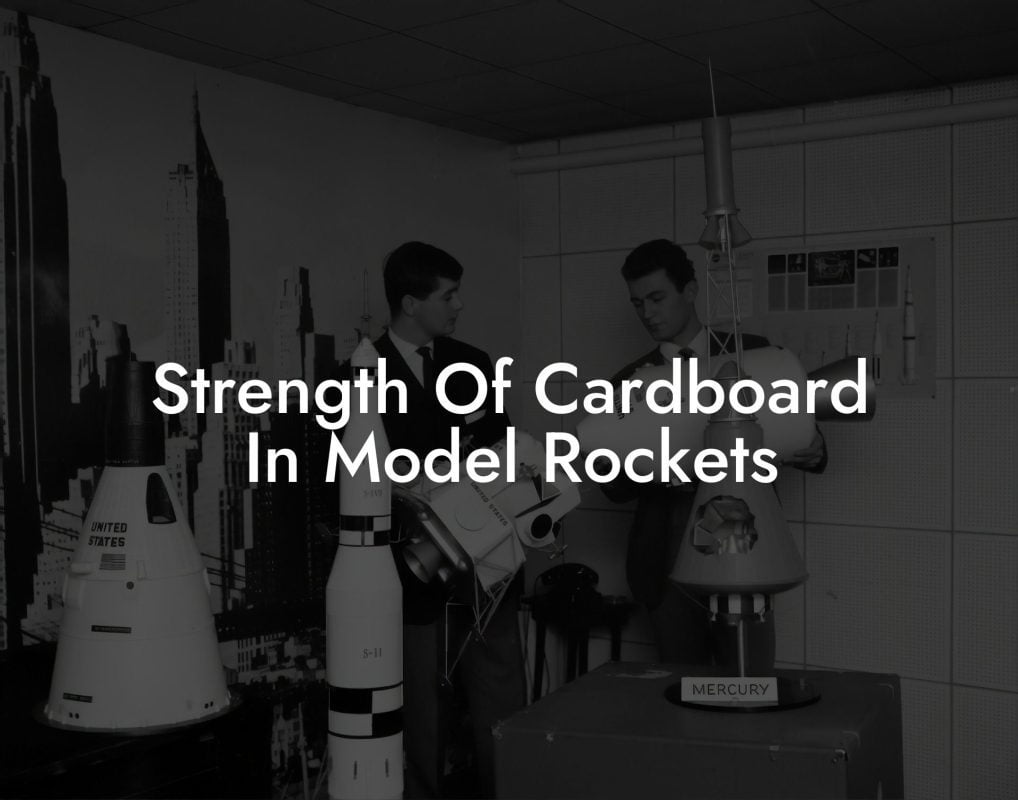Imagine blasting off into the world of model rockets, where the thrill of launching your own creation into the sky meets the satisfaction of learning about the science and technology behind it. Welcome to the ultimate guide to model rocketry, where you'll discover the fascinating terms and concepts that will take your hobby to new heights!
Quick Links to Useful Sections
What Are Model Rockets?
Model rockets are scaled-down versions of real rockets, designed to be launched into the air for recreational purposes. They typically range from simple, low-power rockets to complex, high-performance models that can reach incredible altitudes.
Model rocketry is a fun and educational hobby that combines science, technology, engineering, and mathematics (STEM) principles with creativity and experimentation. Whether you're a beginner or an experienced enthusiast, understanding the terminology used in model rocketry is essential to getting the most out of your hobby.
Key Components of a model rocket
A model rocket typically consists of several key components:
- Nose Cone: The pointed tip of the rocket that helps reduce air resistance during ascent.
- Body Tube: The main structural component of the rocket, which houses the payload, recovery system, and other components.
- Fins: Stabilizing surfaces that provide directional control during flight.
- Motor Mount: The component that holds the rocket motor in place.
- Recovery System: The parachute or other device that slows the rocket's descent and allows it to land safely.
Understanding these components is crucial to designing, building, and launching successful model rockets.
Looking For The Best Model Rocket Kits? You'll Love These:
Types of model rocket Motors
Model rocket motors come in various types, each with its own characteristics and uses:
- A Motors: Low-power motors suitable for small, lightweight rockets.
- B Motors: Mid-power motors used for larger, more complex rockets.
- C Motors: High-power motors designed for advanced, high-performance rockets.
- D Motors: Extremely high-power motors used for the largest, most advanced rockets.
Choosing the right motor for your rocket is critical to achieving the desired performance and safety.
Model Rocket Safety
Safety is paramount in model rocketry. Always follow these guidelines to ensure a safe and enjoyable experience:
- launch Site Selection: Choose a safe, open area with minimal obstacles and no people or animals nearby.
- Launch Angle: Ensure the rocket is launched at a safe angle to avoid collisions or damage.
- Recovery System: Use a reliable recovery system to slow the rocket's descent and prevent damage or injury.
- Motor Handling: Handle motors with care, as they can be hazardous if not handled properly.
By following these safety guidelines, you can minimize the risks associated with model rocketry and enjoy a fun, rewarding hobby.
Model Rocketry Terminology
Familiarize yourself with these essential terms to take your model rocketry skills to the next level:
- Apogee: The highest point reached by a rocket during its flight.
- Burnout: The point at which the rocket motor stops producing thrust.
- Coasting: The phase of flight where the rocket is no longer propelled by the motor.
- Drag: The force that opposes the rocket's motion, caused by air resistance.
- Impulse: The total force exerted by a rocket motor during its burn time.
Mastering these terms will help you better understand the science behind model rocketry and improve your overall performance.
Resources and community Support: Your Next Steps
Join the thriving model rocketry community to connect with like-minded enthusiasts, learn from experts, and stay up-to-date on the latest trends and techniques:
- National Association of Rocketry (NAR): A premier organization for model rocket enthusiasts, offering resources, guidance, and community support.
- Model Rocketry Forums: Online forums and discussion groups where you can ask questions, share knowledge, and learn from others.
- Local Model Rocketry Clubs: Join a local club to meet fellow enthusiasts, participate in launches, and learn from experienced model rocketeers.
By tapping into these resources, you'll gain access to a wealth of knowledge, expertise, and support to help you succeed in model rocketry.
Frequently Asked Questions (FAQs)
Here are some frequently asked questions about model rocketry:
1. What is the best type of model rocket motor for beginners?
A Motors are a great starting point for beginners, as they are easy to use and provide a gentle learning curve.
2. How do I choose the right recovery system for my rocket?
Select a recovery system based on the rocket's size, weight, and altitude to ensure a safe and controlled descent.
3. What safety precautions should I take when launching a model rocket?
Always follow safety guidelines, including launch site selection, launch angle, and recovery system deployment, to minimize risks.
4. How can I improve my model rocket's performance?
Experiment with different motor types, optimize your rocket's design, and fine-tune your launch techniques to achieve better performance.
5. Where can I find model rocketry communities and resources?
Join online forums, attend local model rocketry clubs, and explore national organizations like the NAR to connect with fellow enthusiasts and access valuable resources.
Looking For The Best Model Rocket Kits? You'll Love These:
Useful Interruption: Dive deeper into the world of Model Rockets with our most popular sections. If there is anything you think is missing or anything you would love for us to write about, just give us a shout.
- Getting Started & Basics With Model Rockets
- Model Rocket Design, Build & Customization
- Model Rocket Propulsion & Engine Technology
- Model Rocket Launch Techniques & Recovery
- Model Rocket Advanced Rocketry & Innovations
- Model Rocket DIY and Customization
- Model Rocket Equipment Reviews & Digital Tools
- Community, Competitions & Education
- Model Rocket Troubleshooting & FAQs
- Model Rocket Bonus/Seasonal & Niche Topics
A group of model rocket enthusiasts gathered at a field for their weekly launch event. Among them was Dave, a seasoned builder known for pushing the limits of hobby rocketry. This time, he had outdone himself.
“Ladies and gentlemen,” Dave announced, dramatically pulling a cloth off his latest creation, “I present to you: The Kraken!”
The crowd gasped. This wasn’t just a model rocket—it was a monster. The thing stood 8 feet tall, had six clustered engines, and was covered in enough duct tape to qualify as a classified aerospace project.
“Dave,” muttered Steve, the cautious safety officer, “Have you, uh… done the math on this?”
“Math?” Dave scoffed. “I built it in my garage at 3 a.m. with parts from eBay. This is an art piece, Steve.”
The countdown began.
5…
4…
3…
2…
1…
The engines ignited with a BOOM, and The Kraken shot up… kind of. It immediately did a violent barrel roll, narrowly missing the spectators before skyrocketing at an angle that could only be described as “legally questionable.”
The crowd collectively ducked as The Kraken flew straight over the adjacent cornfield, where Old Man Jenkins, the grumpiest farmer in town, was minding his business.
KABOOM!
The rocket disappeared behind the barn. A moment later, a flaming piece of Estes igniter wire landed at Steve’s feet. The silence was deafening.
And then—an unmistakable sound echoed across the field.
Jenkins’ shotgun being cocked.
“DAVE!!!” Steve shouted. “RUN.”
And that was the day Dave invented the first-ever biologically powered rocket booster: pure adrenaline.
To this day, nobody knows where The Kraken landed, but legend has it, it still haunts the skies, terrifying unsuspecting drones and low-flying birds.















